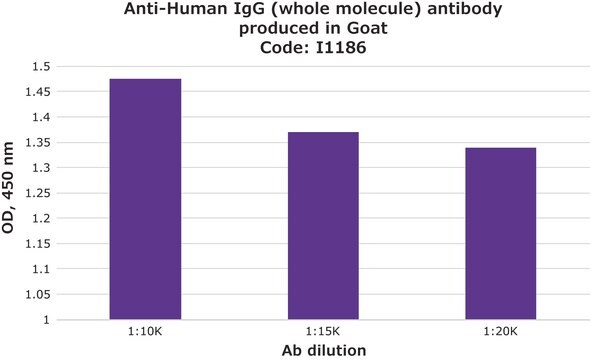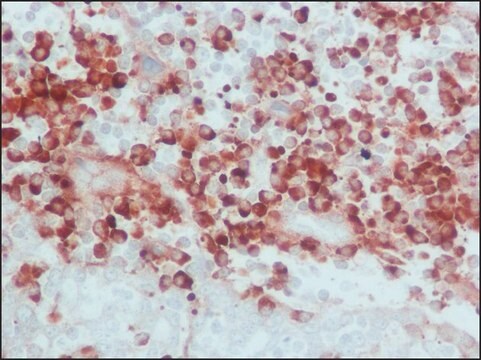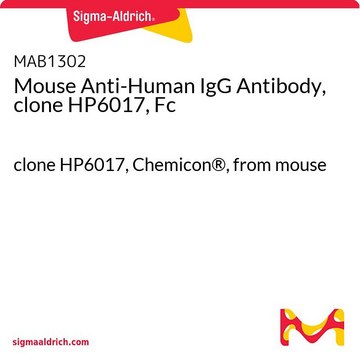추천 제품
생물학적 소스
goat
결합
unconjugated
항체 형태
whole antiserum
항체 생산 유형
secondary antibodies
클론
polyclonal
포함
15 mM sodium azide
기술
indirect ELISA: 1:40,000
quantitative precipitin assay: 4.0 mg/mL
배송 상태
dry ice
저장 온도
−20°C
타겟 번역 후 변형
unmodified
유사한 제품을 찾으십니까? 방문 제품 비교 안내
관련 카테고리
일반 설명
IgG is present in large quantities in the human serum. It constitutes about 10-20% of the plasma proteins. IgG is composed of glycoproteins, out of which it is 82-96% proteins and 4-18% carbohydrates. It consists of four sub-classes i.e IgG1, IgG2, IgG3, and IgG4. IgG is composed of four polypeptide chains-two heavy chains (γ chains) and two light chains (κ or λ chains) which are linked by inter-chain disulfide bonds. The heavy chains consist of a N-terminal variable domain (VH) and three constant domains (CH1, CH2, CH3). A hinge region exists between the CH1 and CH2 region. The light chains have one N-terminal variable domain (VL) and one constant domain (CL). The heavy and the light chains are linked at VH and CH1 domain to form the Fab arm (Fragment antigen binding). The antigen binds to the V regions of the antibody.
애플리케이션
Anti-Human IgG (whole molecule) antibody has been used in
- enzyme linked immunosorbent assay (ELISA)
- printing and processing of reverse phase protein microarrays
- western blot
- radial immunodiffusion
생화학적/생리학적 작용
IgG antibody subtype is the most abundant serum immunoglobulin of the immune system. It is secreted by B cells and is found in blood and extracellular fluids and provides protection from infections caused by bacteria, fungi and viruses. Maternal IgG is transferred to fetus through the placenta that is vital for immune defense of the neonate against infections.
IgG, a monoclonal antibody can be cleaved at the hinge region by nonspecific proteases like papain and pepsin. This can result in univalent Fab fragments or bivalent F(ab′)2 fragments. These two enzymes have a broad substrate specificity resulting in heterogenous fragments.
물리적 형태
Anti-Human IgG is supplied as a liquid containing 15 mM sodium azide as a preservative
저장 및 안정성
For continuous use, store at2-8 °C. For extended storage, the solution may be frozen in working aliquots. Repeated freezing and thawing, or storage in "frost-free" freezers,is not recommended. If slight turbidity occurs upon prolonged storage, clarify the solution by centrifugation before use.
면책조항
Unless otherwise stated in our catalog or other company documentation accompanying the product(s), our products are intended for research use only and are not to be used for any other purpose, which includes but is not limited to, unauthorized commercial uses, in vitro diagnostic uses, ex vivo or in vivo therapeutic uses or any type of consumption or application to humans or animals.
Not finding the right product?
Try our 제품 선택기 도구.
Storage Class Code
10 - Combustible liquids
WGK
nwg
Flash Point (°F)
Not applicable
Flash Point (°C)
Not applicable
시험 성적서(COA)
제품의 로트/배치 번호를 입력하여 시험 성적서(COA)을 검색하십시오. 로트 및 배치 번호는 제품 라벨에 있는 ‘로트’ 또는 ‘배치’라는 용어 뒤에서 찾을 수 있습니다.
Pyruvate kinase M2 and the mitochondrial ATPase Inhibitory Factor 1 provide novel biomarkers of dermatomyositis: a metabolic link to oncogenesis
Santacatterina F, et al.
Journal of Translational Medicine, 15(1), 29-29 (2017)
Evaluation of the immune humoral response of Brazilian patients with Rubinstein-Taybi syndrome
Sugayama S M M, et al.
Brazilian journal of medical and biological research, 43(12), 1215-1224 (2010)
Parmjeet S Randhawa et al.
Clinical and vaccine immunology : CVI, 13(9), 1057-1063 (2006-09-09)
Immunoglobulin G (IgG), IgA, and IgM antibodies were measured in serum samples from 71 organ donors, 81 kidney transplant recipients at transplantation, and 67 patients during the posttransplant period by using a virus-like particle-based enzyme-linked immunosorbent assay (ELISA). BK virus
The role of Fc-receptors in the uptake and transport of therapeutic antibodies in the retinal pigment epithelium
Dithmer M, et al.
Experimental Eye Research, 145(1), 187-205 (2016)
L C Torres et al.
Brazilian journal of medical and biological research = Revista brasileira de pesquisas medicas e biologicas, 43(12), 1215-1224 (2010-11-19)
Rubinstein-Taybi syndrome (RTS) is a rare developmental disorder characterized by craniofacial dysmorphisms, broad thumbs and toes, mental and growth deficiency, and recurrent respiratory infections. RTS has been associated with CREBBP gene mutations, but EP300 gene mutations have recently been reported
자사의 과학자팀은 생명 과학, 재료 과학, 화학 합성, 크로마토그래피, 분석 및 기타 많은 영역을 포함한 모든 과학 분야에 경험이 있습니다..
고객지원팀으로 연락바랍니다.








